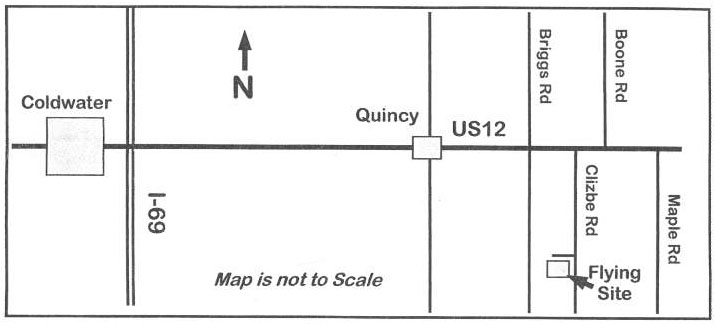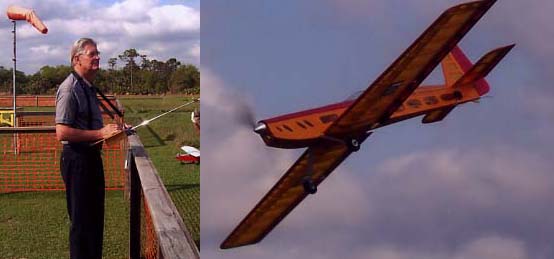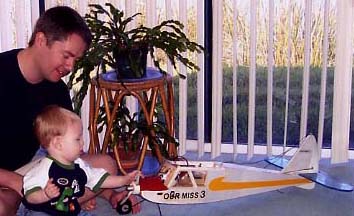 |
Flying High With Electric Power!
The Ampeer ON-LINE!
Fly the Future - Fly Electric! |
Site Table of Contents
| President: | Vice-President: | Secretary/Treasurer: |
| Ken Myers | Richard Utkan | Rick Sawicki |
| 5256 Wildcat | 240 Cabinet | 5089 Ledgewood Ct. W. |
| Croswell, MI 48422 | Milford, MI 48381 | Commerce Twp., MI 48382 |
| (810) 679-3238 | (248) 685-1705 | 248.685.7056 |
 | ||
| Board of Directors: | Board of Directors: | Ampeer Editor |
| David Stacer | Jack Lemon | Ken Myers |
| 16575 Brookland Blvd. | 8908 Sandy Ridge Dr. | 5256 Wildcat Rd. |
| Northville, MI 48167 | White Lake, MI 48386 | Croswell, MI 48422 |
| 248.924.2324 | 248.698.4683 | 810.679.3238 |
| Mailed Ampeer subscriptions are $10 a year US & Canada and $17 a year world wide. FREE on-line! | ||
| The Next Meeting: Date: Saturday, June ?? Time: 10:00 a.m. Place Midwest RC Society 5 Mi Rd. Field | ||
|
By Ken Myers The Fliton "Quiet Storm" ARF was reviewed by Dave Keough in the May 2005 Fly RC p.54 and by John Glezellis in the April 2005 issue of Quiet Flyer p.28.
There is an unexplained weight difference between the two planes being reviewed. The Fly RC version is said to have weighed 16.5 oz. without motor battery while the QF version is said to have weighed 22.4 oz. without motor battery. That is a 5.9 ounce difference. That is significant on this size model. Certainly two ARFs of the identical airplane should be closer in weight.
The following are quotes from John Glezellis in the QF review:
In the Fly RC review, John Keough said the following.
Unlike the QF review, Dave had very little to say about putting the ARF together. He did not note the wing joining problems experienced by John and simply said, "Assembly is straightforward."
References:
Upcoming Coldwater, MI E-vent You are invited to attend the...
June 4 & 5, 2005
|

grifesd@yahoo.com or Phone: 517.279.8445 Please e-mail or call with any questions The Flying Field will be open Friday, June 3 for early arrivals Saturday, June 4, hours are from 9 a.m. 'til 5 p.m. Sunday, June 5, hours are form 9 a.m. 'til 3 p.m. Landing Fee is $10 for the weekend. Directions: Quincy is approximately 4.5 miles east of I-69. Clizbe Road is approximately 1.6 miles east of Quincy. The Flying site is approximately 1.5 miles south of US-12 on the west side of Clizbe Road. Places to Stay:
All except Econo-Lodge are located near I-69 & US-12. Econo-Lodge is on the west side of Coldwater. The April EFO Meeting The meeting was held in conjunction with the Michigan International Soaring Society (MISS). Tom Blazak did a wonderful job of organizing the event. The EFO had a HUGE turnout. The weather was fairly nice, sunny, near 70 degrees most of the day, but with a fairly heavy wind from the south for some of the smaller planes to handle.
|

| MISS provided a "field lunch", and a great time was had by all.
Channel 56, the local PBS station was there to do some videos for an upcoming show on what is happening in the Detroit/Metro Area. The EFO wish to send a HUGE thank you to the folks from MISS for allowing us to share this day with them. Here are some photos of the meet from James Maughan, EFO member. |

An Easy Star Face Off

Jims Mountain Models Switchback
Great Flying Plane

Jim with his 4D
| MISS will be presenting a Flying Extravaganza at Lyon Oaks Park 10 AM to 3 PM on May 21.
Hi Ken,
Take care. Talk to you later,
I was very happy to hear from Rob after test flying his plane at the meeting. I had noted to him that I thought he might be able to use it as a "trainer" if he got help.
Tony Petricca had his new Multiplex EasyStar for me to do the final setup and test fly with him. Like the EasyStar I reviewed, his had the elevator setup in the wrong direction. A quick flip of the elevator switch on the transmitter "fixed" that little problem. I don't know why Multiplex USA doesn't just throw the elevator switch before shipping the model. Makes no sense to me!
Thoughts from Rich Flinchbaugh
Our Electric RC Hobby is unique! We are blessed with some truly remarkable individuals. To name just a few, you modelers in mid-America have Keith Shaw (a man who's always generous with his time - to assist others), then there's the highly respected Patrick del Castillo, another great leader, and innovator. Let's include the Ampeer editor as well!
|

Rev. Thomas Kempf flying his Pretty XL

Mark introducing Jacob to an RC plane.
Higher efficiency Can Motors: Everyone knows that ferrite can motors are at the bottom of the pecking order when it comes to efficiency and brushless motors are at the other end. There are several reasons which all contribute to this, electronic commutation, ball bearings, and magnets. Well we can't do anything about the commutation but cobalt can and some ferrite types have ball bearings. The one thing that sets these apart is the magnet. Ferrites are the weakest; cobalt is two to four times more powerful but neodymium are ten times more powerful than cheapo ferrites. The ferrites are used only where cost is a consideration. What would happen if I substituted the ferrite magnets in a S400 with neodymium magnets?
|

| The second trick was to use a stack of magnets just opposite to the magnet that was being moved into place on the outside of the flux ring. This helped somewhat to negate the magnets tendency to flip over on the inside.
On a can motor I would start from the indentation used to originally hold the ferrite magnets in place. Mount North pole magnets on one side and South pole magnets on the other. Stop when the gap between them is approximately the same as the gap at the indentations. I tested this on an old speed 400 and motor that I had lying around. I removed the end bell and the old ferrite magnets. The new magnet ring was cut so that the ends would perfectly mate with the indentations used to hold the old ferrite rings. It does not matter if the poles are reversed, your motor will simply turn the other direction and all you need do is reverse the leads. I set this up in my homemade thrust test stand and used an old Canadian Tire lead acid battery charger as a power source. I then hooked up a shunt and a volt/ohm meter to test the current levels. I set the charger to the six-volt reading as the 12 V rating would probably of had too much power and I wanted to play it safe. I later found out that the six-volt setting would put out only about 4 V. Earlier I had checked this motor while trying to time it under load with a 6x3 propeller, it had produced in the vicinity of 85 to 90g of thrust at about 4.3 amps. I was shocked to find out that with the new super magnets in place it was now only producing 55 to 60 g of thrust! But looking at the current levels they were down to 3.4 amps. I don't have any method of checking for rpm but rpm/volt must have gone down. That means that torque must've gone up! Ok, so how do I bring the amperage up? Why, use a bigger propeller. I had a seven by four propeller and a fitted that on to the Speed 400 but the current only went up a little bit. I had no 8 in. propellers so I put on a nine by five GWS. Now the current was up to 4.6 amps in but the thrust was a whopping 130g. We achieved a 40-gram increase in thrust by merely exchanging the magnets! I suspect and 8x5 or 8x6 propeller would probably be right on the money as far as amperage is concerned. Nonetheless here I was using the speed 400 to turn a 9x5 propeller. Now, will this compete with an AXI or a Mega? Not a chance! But it is probably in the low range brushless territory. It is also still be substantially less expensive than either of those other two motors. I would suspect that the efficiency is probably in the 65 to 70% range or better. ThatÕs the equivalent of many of the cheap brushless motors out there today. I did try this on an eight-cell pack with an Aircraft World QRP Speed 400 turning a 6x3 propeller and got around 200g of thrust but the supercharged can motor put out nearly 300g of thrust. Please note the battery pack was in bad shape. What would I do if I were to do this again? I would not use the thrust ring at all. Instead I would double stack the super magnets so that they would be 4 mm x 4 mm x 20 mm in size. This would more closely approximate the thickness of the original ferrite magnets and would increase the power even more by bringing the magnets closer to the armature and increasing the flux density. Unfortunately Aircraft World no longer sells those magnets. They and other similar sizes are available from various places on the net. May your ferrite motors never be the same. An Open Letter to the AMA on Bob Kopski's "Retirement"
The May issue of Model Aviation contained Bob Kopski's farewell note in his last column. In the same issue Bob Hunt noted the huge surge of interest in electrically powered flight that had caught the AMA off guard. Somehow these two ideas donÕt seem to go together.
A Further Update on the Alfa Models Corsair Review
Here is another update to my review of Alfa Models Corsair. It has now flown using the brushless direct drive, quite a few times. The main difference is the noise, or lack of it. Performance is very similar, it still climbs nearly vertical, but also flies very well on half throttle. Using the original 800mah Li-Poly packs, I get fed up before they run out. I have also started using an 1800mah 2 cell Li-Poly without any other change. To my surprise this produces about the same power and 7800 rpm as the 3-cell power. It is probably because it is a better pack and will not be restricted by drawing high amps. It is slightly heavier, but does not affect the way the Corsair flies. Duration is unknown as I land after 15 minutes. What has surprised me is its ability to fly in quite high winds.
Regards,
Upcoming Mid-America Electric Flies
Saturday, July 9 & Sunday, July 10, 2005 Hosted by the: Ann Arbor Falcons and Electric Flyers Only
Your Contest Directors are:
Flying both days is at the Midwest R/C Society Flying Field - 5 Mile Rd., Northville Twp., MI Registration: 9 A.M. both days
Narrowband Transmitters are required - Channels 00 through 60, the six 27Mhz frequencies, & eight 53MHz frequencies, will be in use. Flying on five 49 MHz frequencies may be accommodated on request - Narrowband receivers are recommended for flying on Channels 00 - 60 - Very Wideband 27, 49, & 53 MHz, receivers may be accommodated on request Saturday's Events
Sunday's Events
All Planes Must Fly To Be Considered for Any Award Open Flying Possible on Friday
There will be a potluck picnic at the field on Saturday evening. Come and join us for two days of fun and relaxed electric flying.
Come, Look, Listen, Learn - Fly Electric - Fly the Future!
Li-Po Cells versus NiMH
In the June 2005 issue of Quiet Flyer, p. 28, Gary Ritchie took "a look at buying Lithium Polymer Batteries for an 0.40-Size Airplane."
|
To Reach Ken Myers, you can land mail to the address at the top of the page. My E-mail
address is:
KMyersEFO@aol.com
EFO WEBsite: http://members.aol.com/KMyersEFO/